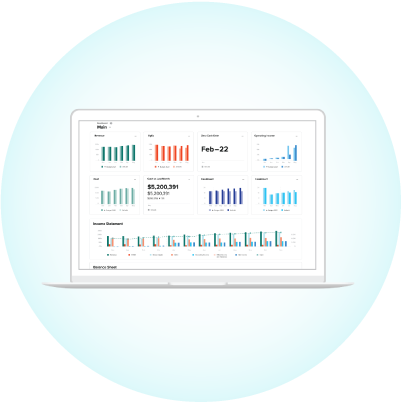In the final post of our series on financial dashboards, we’re going to take a look at how to leverage your dashboard data to make your board reporting more efficient and effective. For a refresh on the rest of the series, we covered how to build dashboards, best practices for maintaining them, and how to use dashboard data to make more informed business decisions.
Though in-person board meetings may be a thing of the past, board reporting is still a necessary business function. If anything, the information you send to your board of directors needs to be more detailed than ever to make up for the difficulties of being remote.
One of the best ways to streamline your board reporting is to use key performance indicators (KPIs) to provide a snapshot survey of what matters most. This article will cover the top 5 KPIs to report to your board, why they’re so critical in a recession, and how best to monitor them.
Let’s get started.
1. Current accounts receivable
Your current accounts receivable includes all of the short-term payments that your business is currently owed but hasn’t collected. Although it is an asset, this is one case where it’s easy to have too much of a good thing. Letting your accounts receivable grow too large or stay on your books for too long is problematic for three reasons:
- The longer your receivables are outstanding, the less likely you are to collect
- Cash is always more valuable today than tomorrow, due to both opportunity cost and inflation
- Delayed cash receipts make it increasingly difficult to handle expenses and liabilities in the short-term
During a recession, your company needs to maximize its cash flow as much as possible. One way to do that without actually increasing your sales is to speed up your collections process and minimize the time that your accounts receivable stays on the books.
The best way to monitor your accounts receivable is with an aging schedule. They organize each customer’s outstanding invoices into groups based on their respective due dates (usually one for every 30 days). Your business can then automate emails, letters, or other follow-ups to help encourage clients to pay.
2. Current accounts payable
Your current accounts payable includes all the short-term bills that your business currently owes but hasn’t yet paid. These expenses are usually the ones that you have on retainer like utilities, office supplies, and advertising.
During a recession, these small debts can quickly become a problem if your business no longer has access to its previous level of revenues. Your board of directors will become concerned if these liabilities increase significantly since it usually indicates a cash flow issue.
Accounts receivable and accounts payable are two sides of the same coin and should be managed similarly. So you’ll need an efficient documentation system in place that keeps your outstanding invoices organized and your records accurate.
Usually, that looks something like the following:
- Purchase orders: These are confirmation forms that include the initial details of a request for goods or services and ensure your company’s funds are only used for approved expenses.
- Receiving reports: Created by the supplier, this should be matched to the original purchase order to make sure no mistakes were made during fulfillment.
- Invoices: Invoices are the final documentation that includes all of the payment details. Unpaid invoices make up your current accounts payable, and should be organized well to avoid an inaccurate KPI and doubling up of payments.
3. Working capital
Working capital is the difference between your current assets (cash, accounts receivable, inventory, etc.) and your current liabilities (accounts payable, accrued liabilities, etc.). Assets and liabilities are defined as current if they’re expected to be accessible or due within the next twelve months.
Working capital is a KPI that measures your solvency, which is your ability to pay your debts. In this case, whether you’ll be able to cover any debts that come due in the next year with your cash and liquid assets.
It’s another metric that becomes more important during times of economic uncertainty. In difficult times, your board of directors will prioritize the company’s survivability. And since debt is inherently risky, it needs to be on the watch list.
If you don’t have enough cash to pay for your liabilities when they come due, you’ll start to incur penalties and interest very quickly. Even worse, you may have to sell some of your important fixed assets, take on additional debt, or declare bankruptcy to solve the problem.
4. Operating cash flow
Your operating cash flows track the amount of cash generated by your standard business operations and is the most accurate representation of your company’s profitability. Metrics like net cash flows and net income are distorted by things like financing cash flows and non-cash expenses respectively.
During a recession, your board of directors will definitely want to keep an eye on cash flows and cash reserves. Your business should be in defense mode, and your board is going to want to be sure that each dollar is put to good use and that the company’s future is secure.
A significant decrease in operating cash flows is the first sign that something is significantly wrong and that a new strategy may be necessary to preserve the company.
Use this formula to calculate and monitor your operating cash flows:
Operating Cash Flows = Net Income + Noncash Expenses +/- Change in Working Capital
There are no hard and fast rules for what constitutes a good result, except of course that it should be as large and as positive as possible. Whatever your typical cash flows are, any significant decrease in your operating cash flows during a recession will be of interest to the board and should be investigated as soon as possible.
5. Net profit margin
Your net profit margin is the ratio of your net income to your gross revenues, usually expressed in a percentage. It’s another profitability KPI and reflects how much of your company’s earnings you keep after deducting both cost of goods sold and operating expenses.
Net profit margin is one of the most important KPIs to keep track of during a recession since it’s a dynamic representation of your company’s health as a whole. In contrast, most profitability metrics can only tell you one piece of the picture.
For example:
There’s a sudden and significant decrease in revenues, which tells you that something has happened to drive down your sales. That always looks like a bad thing upon first glance, but it isn’t necessarily a cause for alarm.
If you zoom out and find that your net profit margin hasn’t decreased, it means that some of your larger expenses have also decreased.
A possible explanation is that you recently stopped selling to a client that was consistently failing to pay, and they were artificially increasing your revenues (when they never paid) and expenses (when you have to write off bad-debt).
Make sure your dashboard tracks the right data
During a recession, your KPIs matter more than ever. You need to be quick and flexible with your decision making. Organizing all of your information properly for both you and your board of directors is a big part of executing that.
We can’t be sure how long the pandemic will last, and the subsequent economic fallout will probably last even longer. But in the meantime, make sure that you’re tracking the right data and presenting it in a useful, accessible way.
Jirav can help you use your data to navigate these uncertain times with confidence. Take a tour of the product today to get a closer look at the dashboard features and how they can help your reporting process.












